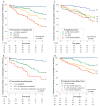Right Heart End-Systolic Remodeling Index Strongly Predicts Outcomes in Pulmonary Arterial Hypertension: Comparison With Validated Models
- PMID: 28592589
- PMCID: PMC5527228
- DOI: 10.1161/CIRCIMAGING.116.005771
Right Heart End-Systolic Remodeling Index Strongly Predicts Outcomes in Pulmonary Arterial Hypertension: Comparison With Validated Models
Abstract
Background: Right ventricular (RV) end-systolic dimensions provide information on both size and function. We investigated whether an internally scaled index of end-systolic dimension is incremental to well-validated prognostic scores in pulmonary arterial hypertension.
Methods and results: From 2005 to 2014, 228 patients with pulmonary arterial hypertension were prospectively enrolled. RV end-systolic remodeling index (RVESRI) was defined by lateral length divided by septal height. The incremental values of RV free wall longitudinal strain and RVESRI to risk scores were determined. Mean age was 49±14 years, 78% were female, 33% had connective tissue disease, 52% were in New York Heart Association class ≥III, and mean pulmonary vascular resistance was 11.2±6.4 WU. RVESRI and right atrial area were strongly connected to the other right heart metrics. Three zones of adaptation (adapted, maladapted, and severely maladapted) were identified based on the RVESRI to RV systolic pressure relationship. During a mean follow-up of 3.9±2.4 years, the primary end point of death, transplant, or admission for heart failure was reached in 88 patients. RVESRI was incremental to risk prediction scores in pulmonary arterial hypertension, including the Registry to Evaluate Early and Long-Term PAH Disease Management score, the Pulmonary Hypertension Connection equation, and the Mayo Clinic model. Using multivariable analysis, New York Heart Association class III/IV, RVESRI, and log NT-proBNP (N-Terminal Pro-B-Type Natriuretic Peptide) were retained (χ2, 62.2; P<0.0001). Changes in RVESRI at 1 year (n=203) were predictive of outcome; patients initiated on prostanoid therapy showed the greatest improvement in RVESRI. Among right heart metrics, RVESRI demonstrated the best test-retest characteristics.
Conclusions: RVESRI is a simple reproducible prognostic marker in patients with pulmonary arterial hypertension.
Keywords: echocardiography; heart failure; patient outcome assessment; pulmonary hypertension; right ventricular dysfunction; risk assessment; ventricular remodeling.
© 2017 American Heart Association, Inc.
Figures








Comment in
-
Respite for 2-Dimensional Right Ventricular Imaging?Circ Cardiovasc Imaging. 2017 Jun;10(6):e006564. doi: 10.1161/CIRCIMAGING.117.006564. Circ Cardiovasc Imaging. 2017. PMID: 28592590 No abstract available.
References
-
- McLaughlin VV, Archer SL, Badesch DB, Barst RJ, Farber HW, Lindner JR, Mathier MA, McGoon MD, Park MH, Rosenson RS, Rubin LJ, Tapson VF, Varga J, Harrington RA, Anderson JL, Bates ER, Bridges CR, Eisenberg MJ, Ferrari VA, Grines CL, Hlatky MA, Jacobs AK, Kaul S, Lichtenberg RC, Lindner JR, Moliterno DJ, Mukherjee D, Pohost GM, Rosenson RS, Schofield RS, Shubrooks SJ, Stein JH, Tracy CM, Weitz HH, Wesley DJ, ACCF/AHA ACCF/AHA 2009 expert consensus document on pulmonary hypertension: a report of the American College of Cardiology Foundation Task Force on Expert Consensus Documents and the American Heart Association: developed in collaboration with the American College of Chest Physicians, American Thoracic Society, Inc., and the Pulmonary Hypertension Association. Circulation. 2009;119:2250–2294. - PubMed
-
- Galiè N, Humbert M, Vachiery JL, Gibbs S, Lang I, Torbicki A, Simonneau G, Peacock A, Vonk Noordegraaf A, Beghetti M, Ghofrani A, Gomez Sanchez MA, Hansmann G, Klepetko W, Lancellotti P, Matucci M, McDonagh T, Pierard LA, Trindade PT, Zompatori M, Hoeper M, Aboyans V, Vaz Carneiro A, Achenbach S, Agewall S, Allanore Y, Asteggiano R, Paolo Badano L, Albert Barberà J, Bouvaist H, Bueno H, Byrne RA, Carerj S, Castro G, Erol Ç, Falk V, Funck-Brentano C, Gorenflo M, Granton J, Iung B, Kiely DG, Kirchhof P, Kjellstrom B, Landmesser U, Lekakis J, Lionis C, Lip GYH, Orfanos SE, Park MH, Piepoli MF, Ponikowski P, Revel MP, Rigau D, Rosenkranz S, Völler H, Luis Zamorano J. 2015 ESC/ERS Guidelines for the diagnosis and treatment of pulmonary hypertension: The Joint Task Force for the Diagnosis and Treatment of Pulmonary Hypertension of the European Society of Cardiology (ESC) and the European Respiratory Society (ERS): Endorsed by: Association for European Paediatric and Congenital Cardiology (AEPC), International Society for Heart and Lung Transplantation (ISHLT) Eur Heart J. 2016;37:67–119. - PubMed
-
- D'Alonzo GE, Barst RJ, Ayres SM, Bergofsky EH, Brundage BH, Detre KM, Fishman AP, Goldring RM, Groves BM, Kernis JT. Survival in patients with primary pulmonary hypertension. Results from a national prospective registry. Ann Intern Med. 1991;115:343–349. - PubMed
-
- Ghio S, Recusani F, Klersy C, Sebastiani R, Laudisa ML, Campana C, Gavazzi A, Tavazzi L. Prognostic usefulness of the tricuspid annular plane systolic excursion in patients with congestive heart failure secondary to idiopathic or ischemic dilated cardiomyopathy. Am J Cardiol. 2000;85:837–842. - PubMed
-
- Benza RL, Miller DP, Gomberg-Maitland M, Frantz RP, Foreman AJ, Coffey CS, Frost A, Barst RJ, Badesch DB, Elliott CG, Liou TG, McGoon MD. Predicting survival in pulmonary arterial hypertension: insights from the Registry to Evaluate Early and Long-Term Pulmonary Arterial Hypertension Disease Management (REVEAL) Circulation. 2010;122:164–172. - PubMed
Publication types
MeSH terms
Grants and funding
LinkOut - more resources
Full Text Sources
Other Literature Sources
Medical
Research Materials

